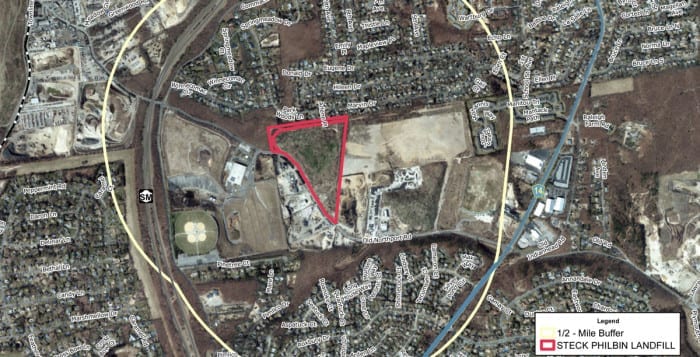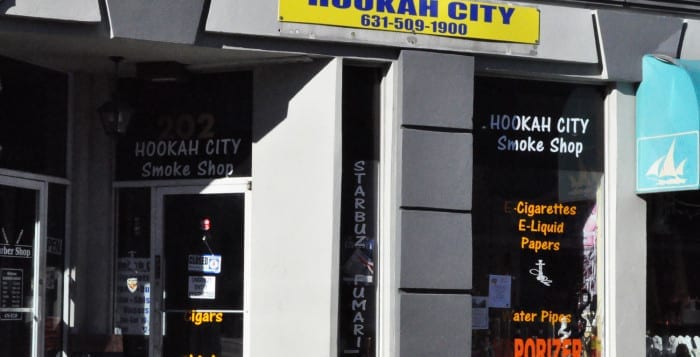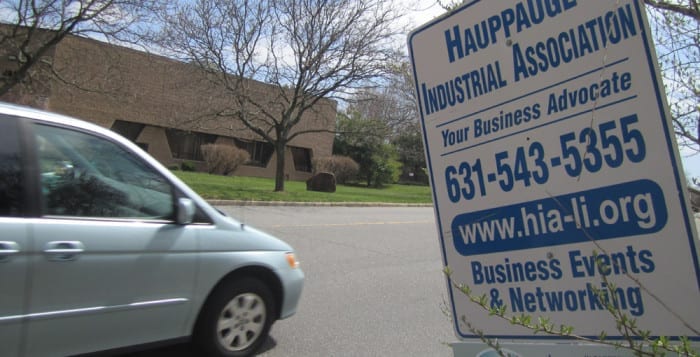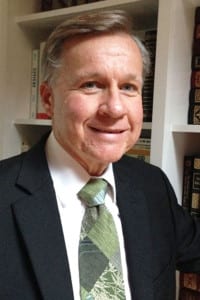A former landfill in Kings Park has been transferred into the hands of a nearby developer with the intention of rehashing the site into a solar farm.
The site of the former Steck-Philbin Landfill on Old Northport Road in Kings Park has withstood 30 years of tax delinquency but was selected as part of an effort from the Suffolk County Landbank Corp. to be revitalized along with seven other brownfields across the county. Suffolk County Executive Steve Bellone (D) signed the transfer of the property into law on June 2, allowing Landbank — a not-for-profit — to begin revisioning the parcel with developer Powercrush Inc., of Kings Park, with the goal of reusing the site for solar farming.
Powercrush Inc. did not return requests seeking comment, but Bellone heralded the deal as a turning point for blighted spots on Long Island.
“These properties have been a burden on our taxpayers and a blight on our communities,” Bellone said. “The inactivity at these locations dragged down neighboring property values and served as magnets for criminal activity.”
The site in Kings Park is still owned by Richard and Roslyn Steck of Steck & Philbin Development Co., though penalties and interest bring the total owed in property tax on the roughly 25 acres of land to nearly $1.5 million. The property has been tax delinquent since Steck & Philbin Development Co. was found to be using the site to dispose of waste for which they did not have a permit in 1986. It is located less than a half mile east of the Sunken Meadow Parkway and about a half mile west of Indian Head Road.
The property is next to the future location of a multisport complex being developed by Prospect Sports Partners LLC. The $33 million plan for the 44-acre site was approved in July 2015.
A property is classified as a brownfield if there are complications in expansion or redevelopment based on the possible presence of pollutants or hazardous materials, according to the United States Environmental Protection Agency.
The Suffolk County Landbank was established in 2013 after its application was approved by the New York State Empire State Development Corporation. Some of the other brownfields included in the request for proposals include Hubbard Power and Light and a gas station on Brentwood Road in Bay Shore, Lawrence Junkyard in Islip and Liberty Industrial Finishing in Brentwood, among others. The group issued a competitive Request For Proposals (RFP) to the public for redevelopment of the eight specific sites and selected three developers to take title to four sites.
The four sites, on average, have been tax delinquent for 21 years and cumulatively owe over $4 million in back taxes. Once back on the tax rolls, the properties would pay a cumulative property tax of more than $175,000 per year.
The developers selected “possessed the qualifications and expertise to clean up the properties and reuse them in a way that benefits the community, stabilizes the tax base, and protects Suffolk County’s soil and groundwater,” the county said in a statement.
Amy Keys, executive director of the Landbank, said Powercrush was selected based on a number of qualifications, including design, impact and feasibility. Its partnership with BQ Energy LLC, which has worked on several solar projects across the region.
“[Smithtown] was clear they were supportive of solar happening there,” Keys said. “When reviewing solar proposals, we were looking for experience in developing solar on that scale, and a proposal that seemed feasible.”
Shawn Nuzzo, president of Ecological Engineering of Long Island, had also submitted a proposal for the site that he said had the potential to pump renewable energy into the Island’s power grid almost immediately. His proposal included a 6-megawatt solar farm as the largest landfill-to-solar project in New York State that could generate nearly 8 million kilowatt hours of solar electricity in its first year. The plan received support from various North Shore elected officials, including state Assemblyman Steve Englebright (D-Setauket) and others.
In an interview, Nuzzo said he was disappointed to learn of the county’s selection of Powercrush Inc. and accused the county of playing politics.
“This is the exact sort of ‘pay-to-play’ system that politicians like to say that they are against, but at the end of the day willingly corroborate, or at least turn a blind eye to. The seemingly endless series of Suffolk political scandals only serves to affirm that there must be a lot of blind eyes in Suffolk County politics,” Nuzzo said. “Despite the fact that the Suffolk County Legislature voted on the proposal and County Executive Bellone announced it at a press conference more than two weeks ago, the details of the proposal remain secret to the public. Our most recent [Freedom of Information Law] attempts have been thwarted by the Suffolk County Landbank. I can only speculate that the winning proposal was so inadequate and incomplete that the county is embarrassed to share it. It’s a shame, because our proposal to build Long Island’s first community-owned solar farm could have been a landmark moment for Suffolk County. Instead what we got was politics as usual.”








